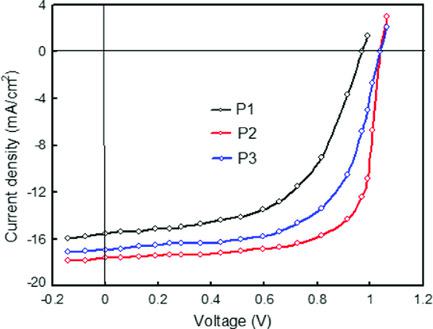当前位置:
X-MOL 学术
›
Energy Technol.
›
论文详情
Our official English website, www.x-mol.net, welcomes your
feedback! (Note: you will need to create a separate account there.)
New High‐Bandgap 8,10‐Dihydro‐9H‐Bistieno[2′,3′:7.8;3″,2″:5.6]Naphtho[2,3‐d] Imidazole‐9‐One‐Based Donor–Acceptor Copolymers for Nonfullerene Polymer Solar Cells
Energy Technology ( IF 3.6 ) Pub Date : 2020-08-25 , DOI: 10.1002/ente.202000611 Muhammed L. Keshtov 1 , Sergei A. Kuklin 1 , Ilya E. Ostapov 1, 2 , Elena E. Makhaeva 2 , Rakesh Suthar 3 , Chuandong Dou 4 , Ganesh D. Sharma 3
Energy Technology ( IF 3.6 ) Pub Date : 2020-08-25 , DOI: 10.1002/ente.202000611 Muhammed L. Keshtov 1 , Sergei A. Kuklin 1 , Ilya E. Ostapov 1, 2 , Elena E. Makhaeva 2 , Rakesh Suthar 3 , Chuandong Dou 4 , Ganesh D. Sharma 3
Affiliation

|
Three D–A conjugated copolymers based on the same 8,10‐dihydro‐9H‐bisthieno[2′,3′:7.8;3″,2″:5.6]naphtho[2,3‐d]imidazol‐9‐one (DTNIA) acceptor unit and different donor units, i.e., 2‐dodecylbenzo[1,2‐b:3,4‐b′:6,5‐b″]trithiophene (3TB) (P1), 5,6‐dioctylnaphtho[2,1‐b:3,4‐b′]dithiophene (DTN) (P2), and 4,5‐diundecylbenzo[2,1‐b:3,4‐b′]dithiophene (DTB) (P3), are formulated and synthesized. All the copolymers exhibit deep highest occupied molecular energy levels of −5.43, −5.50, and −5.51 eV for P1, P2, and P3, respectively, and show an optical bandgap of 2.18, 2.12, and 2.11 eV, for P1, P2, and P3, respectively. These copolymers are used as donors for the construction of polymer solar cells combining ITIC‐m as an electron acceptor. The optimized polymer solar cells based on P1:ITIC‐m, P2:ITIC‐m, and P3:ITIC‐m realize overall power conversion efficiency of ≈9.62%, 12.84%, and 11.80%, respectively. The greater value of open circuit voltage for P2 and P3 relative to P1 may be due to the deeper highest occupied molecular orbital energy level of P2 and P3 as compared to P1. The highest power conversion efficiency for the P2‐based polymer solar cells may be originated from the denser π–π stacking distance and relatively improved crystallinity, which are advantageous for balanced charge transport, resulting in a comparatively high fill factor and short circuit current.
中文翻译:

新型高能隙的8,10-二氢-9H-Bistieno [2',3':7.8; 3“,2”:5.6]萘[2,3-d]咪唑-9-单基供体-受体共聚物非富勒烯聚合物太阳能电池
基于相同的8,10-dihydro-9H-bisthieno [2',3':7.8; 3“,2”:5.6]萘[2,3-d]咪唑-9-one(3)的三种D–A共轭共聚物( DTNIA)受体单位和不同的供体单位,即2-十二烷基苯并[1,2-b:3,4-b':6,5-b'']三噻吩(3TB)(P1),5,6-二辛基萘[2] ,1-b:3,4-b']二噻吩(DTN)(P2),和4,5-二diundecylbenzo并[2,1-b:3,4-b']二噻吩(DTB)(P3),进行了配方和合成。对于P1,P2和P3,所有共聚物均显示出最深的最高分子能量能级,分别为-5.43,-5.50和-5.51 eV,对于P1,P2,其光学带隙分别为2.18、2.12和2.11 eV。和P3分别。这些共聚物被用作结合ITIC-m作为电子受体的聚合物太阳能电池的供体。基于P1:ITIC-m,P2:ITIC-m和P3: ITIC-m的优化聚合物太阳能电池分别实现了约9.62%,12.84%和11.80%的总功率转换效率。相对于P1,P2和P3的开路电压值较大可能是由于P2和P3的最高占据分子轨道能级比P1更高。P2型聚合物太阳能电池的最高功率转换效率可能源自更密集的π-π堆叠距离和相对改善的结晶度,这有利于平衡电荷传输,从而导致较高的填充因子和短路电流。
更新日期:2020-10-05
中文翻译:

新型高能隙的8,10-二氢-9H-Bistieno [2',3':7.8; 3“,2”:5.6]萘[2,3-d]咪唑-9-单基供体-受体共聚物非富勒烯聚合物太阳能电池
基于相同的8,10-dihydro-9H-bisthieno [2',3':7.8; 3“,2”:5.6]萘[2,3-d]咪唑-9-one(3)的三种D–A共轭共聚物( DTNIA)受体单位和不同的供体单位,即2-十二烷基苯并[1,2-b:3,4-b':6,5-b'']三噻吩(3TB)(P1),5,6-二辛基萘[2] ,1-b:3,4-b']二噻吩(DTN)(P2),和4,5-二diundecylbenzo并[2,1-b:3,4-b']二噻吩(DTB)(P3),进行了配方和合成。对于P1,P2和P3,所有共聚物均显示出最深的最高分子能量能级,分别为-5.43,-5.50和-5.51 eV,对于P1,P2,其光学带隙分别为2.18、2.12和2.11 eV。和P3分别。这些共聚物被用作结合ITIC-m作为电子受体的聚合物太阳能电池的供体。基于P1:ITIC-m,P2:ITIC-m和P3: ITIC-m的优化聚合物太阳能电池分别实现了约9.62%,12.84%和11.80%的总功率转换效率。相对于P1,P2和P3的开路电压值较大可能是由于P2和P3的最高占据分子轨道能级比P1更高。P2型聚合物太阳能电池的最高功率转换效率可能源自更密集的π-π堆叠距离和相对改善的结晶度,这有利于平衡电荷传输,从而导致较高的填充因子和短路电流。











































 京公网安备 11010802027423号
京公网安备 11010802027423号